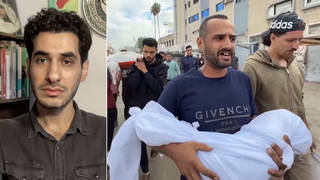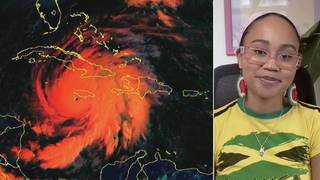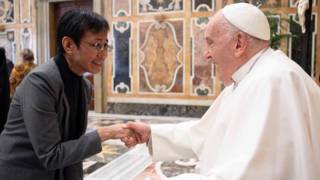
While the Philippines struggles to rebuild after Typhoon Haiyan, the country is being forced to continue paying out billions of dollars in debt to the World Bank and other lenders. Haiyan, the strongest typhoon to ever hit land, affected more than 14 million people in 44 provinces in the central Philippines, killing 6,000, displacing more than four million, leaving nearly 1,800 missing, and damaging about one million homes. On Christmas Eve, the Philippines reached a grim milestone: $1 billion in debt payments since the typhoon hit. Some of those debts are from the corrupt and abusive regime of Ferdinand Marcos, which enjoyed the early backing of the Ronald Reagan administration. During their 20 years in power, the Marcoses embezzled $5 to $10 billion from their people, a debt Filipinos continue to carry today. To explain the debt and how the country is coping after the storm, we are joined by Eric LeCompte, executive director of Jubilee USA Network.
Transcript
JUAN GONZÁLEZ: We turn now to the Philippines, where the holidays were observed with a mixture of gratitude and somberness, as the country continues to recover from Typhoon Haiyan, which reduced almost everything in its path to rubble two months ago. Haiyan, the strongest typhoon to ever hit land, affected more than 14 million people in 44 provinces in the central Philippines. It killed at least 6,000 people, displaced more than four million residents, and damaged about one million houses, leaving nearly 1,800 people missing.
On Saturday, United Nations Secretary-General Ban Ki-moon visited Tacloban, the epicenter of the typhoon, and urged international community to scale up support for Philippines recovery and reconstruction efforts.
SECRETARY-GENERAL BAN KI-MOON: I was deeply moved and also inspired by my visit to Tacloban. People are working hard to recover. We must not allow this to be another forgotten crisis. I urge all donors to add to their already generous response so that we can help communities to build back better and safer.
AMY GOODMAN: That was U.N. Secretary-General Ban Ki-moon. This week, the U.N. announced an appeal for $800 million in international humanitarian relief. So far, only 30 percent of the target has been met.
Amidst the ongoing crisis, some may be shocked to learn that the Philippines’ debt repayments far overshadow all the Typhoon Haiyan relief assistance to date. On Christmas Eve, the Philippines reached a grim milestone: $1 billion in debt payments since the typhoon hit. Some of those debts are from the corrupt and abusive regime of dictator Ferdinand Marcos, which enjoyed the early backing of the Reagan administration. In the 1980s, the White House described Marcos as, quote, “an old friend and longtime ally.” During their 20 years in power, the Marcoses embezzled $5 to $10 billion from their people, according to a joint U.N. and World Bank report. It’s a debt Filipinos continue to carry today.
For more, we go to Washington, D.C., where we’re joined by Eric LeCompte. He is the executive director of Jubilee USA Network.
Eric, welcome to Democracy Now! Talk about this debt and what this means, given how hard hit the Philippines is from the typhoon.
ERIC LECOMPTE: Well, I think, as you explained, the devastation is absolutely horrific on the ground. Six thousand people have died. There’s been economic losses of over $15 billion. And there’s a reality, as 10 to 12 typhoons continue to hit the country every year, they’re unprepared for climate change and future catastrophic typhoons, which are expected to arrive and hit shore over the next 10 years. So when we’re looking at the amount of aid so far, it’s been absolutely incredible how countries around the world have delivered about $350 million in aid, $51 million from the U.S. government alone, but it’s completely dwarfed by the debt payments that are continued to be made by the country of the Philippines. They’re paying down over $60 billion in debt. This year alone, they will pay over $6.7 billion; since the typhoon hit, over a billion dollars. So, we see that the amount of debt is unsustainable. Over 20 percent of the income of the Philippines goes towards paying down the debt.
And what makes this whole situation even worse is that the roots of this debt are from the corrupt regime of Ferdinand Marcos. And, you know, Ferdinand Marcos, under his dictatorship in the Philippines, more than 3,000 people were killed; 35,000 people were tortured. You know, I was 10 years old when finally the nonviolent revolution unseated the dictatorship of Ferdinand Marcos. And I will never forget seeing the television images of Imelda Marcos’s shoe collection of over 3,000 designer pairs of shoes. While the country was in poverty, while people were being tortured, this couple was embezzling between $5 and $10 billion. So, we have to understand that in the current context of what’s happening in the Philippines, that there’s no way the country can get back on its feet without dealing with this unsustainable debt, with its roots in the corrupt Marcos regime.
JUAN GONZÁLEZ: Well, Eric, your mention of the Marcos regime—I want to turn to an interview that Al Jazeera correspondent Veronica Pedrosa did with Imelda Marcos. This is an excerpt.
VERONICA PEDROSA: He enriched himself, didn’t he?
IMELDA MARCOS: How would he? He was rich.
VERONICA PEDROSA: You were enriching yourselves.
IMELDA MARCOS: He was rich. He was rich when he and I got married. In fact, before he became president, he was number four. And you can see that in an interview in the Reader’s Digest. He was number four in the payment of taxes.
VERONICA PEDROSA: But, Mrs. Marcos, isn’t it true that $10 billion of the Philippine treasury money went missing?
IMELDA MARCOS: It’s not true. It’s not true, because then we—I should have been in jail already. I’ll show you the documents.
VERONICA PEDROSA: Well, where is the money, though, madam? If you—it’s OK, you can—yeah.
IMELDA MARCOS: We have not stolen any money.
JUAN GONZÁLEZ: That was Imelda Marcos being interviewed by Veronica Pedrosa of Al Jazeera. I wanted to ask you, the Marcoses have been—were overthrown decades ago, and how is it possible that the debt is still being paid by the Philippine government?
ERIC LECOMPTE: Well, a big part of it is interest rates. So, you know, what we know is that the government, the dictatorship, took out more than $25 billion in loans, that we know of, that we’re aware of, and that the principal of many of those loans have been paid. But what’s remarkable is that the interest rates have grown to such amount that, you know, the loans have continued to grow. I think one of the problems that we’re seeing—and this isn’t a problem that’s just endemic to the Philippines—but the reality of it is, is of this $60 billion of debt, we don’t know completely who it’s owed to, what the $60 billion paid for, what benefits happened from the $60 billion, and, you know, whether or not the government of the Philippines at any time, even recently, has sought approval of its people in order to transact and to be able to take loans.
AMY GOODMAN: Where was the embezzled money? Why can’t it be found?
ERIC LECOMPTE: Well, you know, so—that’s a U.N. and a World Bank report that say from—what their estimates—and their estimates range between $5 billion and $10 billion. I’m sure for many of the listeners of Democracy Now!, there’s quite a difference between $5 billion and $10 billion. It’s astounding that these are just projections. These are just estimates. You know, much of this money was hidden by the Marcos regime. And as the Marcoses fled the Philippines, they certainly took a lot of that money with them.
I think one of the issues that we’re dealing with in the international financial system is also how our financial system supports corruption. Through the use of tax havens, through the use of secret bank accounts, many corrupt officials continue to be able to hide moneys around the world. And I think these are some of the problems that—you know, it’s much bigger than just the Philippines, when we’re counting debt right now in the trillions of dollars around the world, that the financial crisis was caused by high indebtedness, by speculation, and, you know, the international financial system still is not providing rules to deal with these problems.
And when we go back to the Philippines, you know, there still aren’t even rules in place in the Philippines, like in many countries around the world, where a country’s leader needs to seek approval from even their parliament or their congress in order to take out loans and spend that money.
AMY GOODMAN: So, Eric, can you just talk about what you’re calling for?
ERIC LECOMPTE: So, you know, specifically in terms of the Philippines, we join our partners at Jubilee Asia-Pacific and the Freedom from Debt Coalition on the ground in the Philippines, and we’re asking President Jim Kim of the World Bank to immediately have a moratorium on debt payments. The World Bank, as well as the Asian Development Bank, hold the majority of loans in the Philippines right now. So we want a moratorium on the debt.
The second part, which is critical, is there needs to be a public, independent audit. We need to know what the money was spent on, where the money went, how the money was approved, and where the money is now, and actually who all the money is loaned—is owed to. And I think these are critical things in regards to the Philippines.
More broadly, for us at Jubilee USA and our international partners, you know, we want to see debt audits take place around the world. We want to see the implementation of an international bankruptcy process to work out these unsustainable debts. And we want to see basic regulations for responsible lending and borrowing implemented in the international financial system.
JUAN GONZÁLEZ: And we just have about 20 seconds, and you said that the World Bank has most of the debt, but do you know any of the major U.S. banks that have a portion of the Philippine debt?
ERIC LECOMPTE: So, about 5 percent of the debt right now is either held by the U.S. government or by U.S. banks, again, going back to the Marcos regime. Without an audit, we don’t know the exact breakdowns. So that’s why an audit is so important right now.
AMY GOODMAN: Eric LeCompte, we want to thank you for being with us, executive director of Jubilee USA.












Media Options